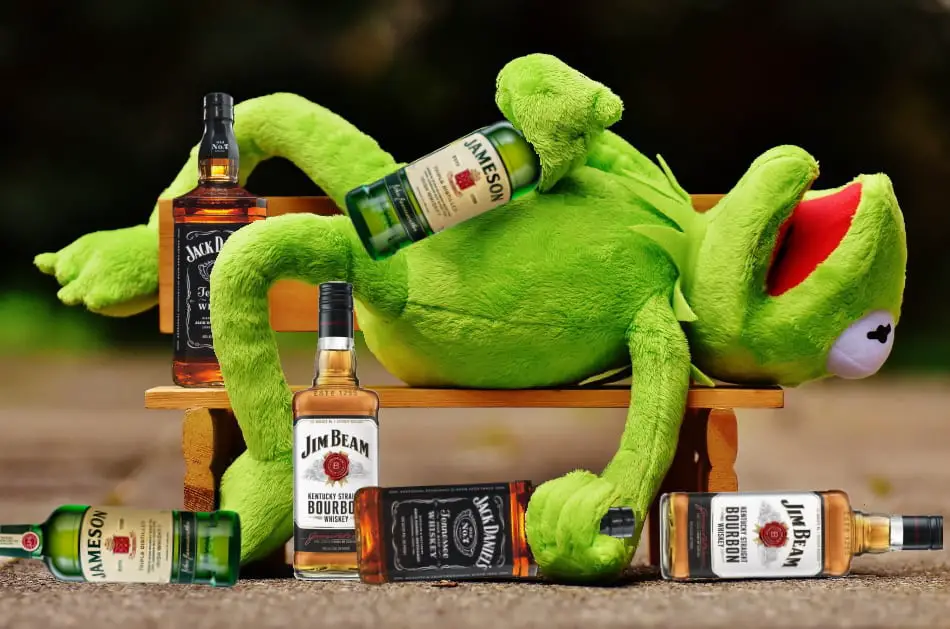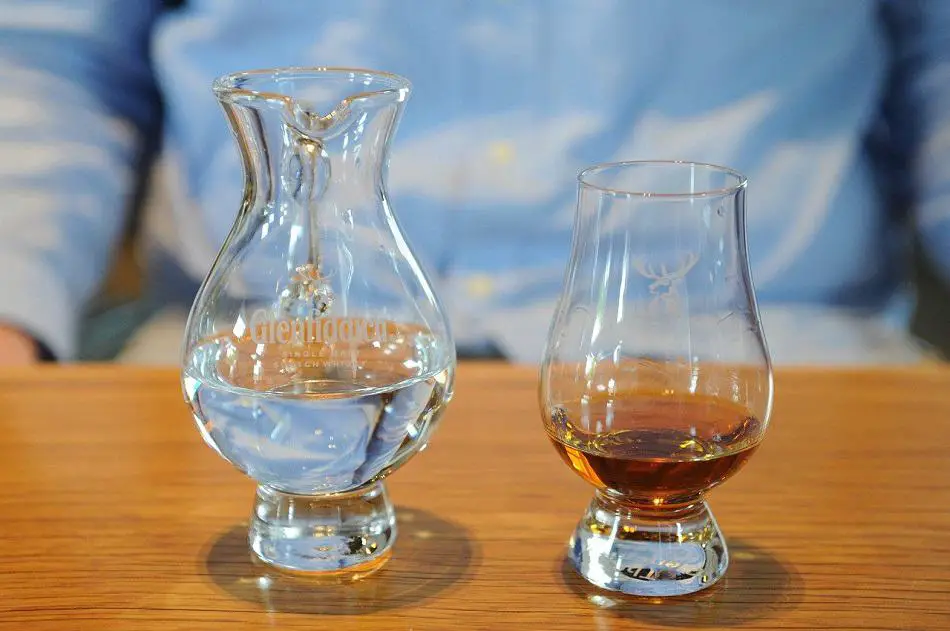Whiskey has a high alcohol content level (between 40% – 68%ABV), much more than wine (about 12%ABV) or beer (about 5%ABV) and it’s common for whiskey drinkers to have several glasses in one session, especially when they’re comparing different whiskeys. However, they have to be careful that they don’t end up intoxicated. That’s why I wanted to share with you 6 tips I use for drinking whiskey without getting drunk.
1. Know How Much Alcohol You Can Handle
Everybody’s different so the number of drinks it takes to become intoxicated will vary from person to person. It’s important to know what factors affect the rate of intoxication so that you can better judge your resistance to alcohol and how much whiskey you can handle without getting drunk.

Age
Age affects the rate of intoxication because younger people are at the peak of their health and have a faster metabolism, so they’ll get drunk more slowly.
Sex
Women are usually smaller than men so when both consume the same amount of alcohol, they’ll end up with a higher Blood Alcohol Content (BAC) level (i.e., they’ll get drunk quicker). Even at the same weight women become intoxicated faster than men because of various factors that cause their bodies to process alcohol less efficiently.
Body Weight
Body weight determines the amount of space through which alcohol can diffuse in the body. The more you weigh the lower your BAC and the slower you’ll get drunk.
Body Fat
Alcohol can’t be dissolved in fat, so the higher your body fat the more alcohol becomes concentrated in your blood (meaning a higher BAC) and the quicker you’ll get drunk.
Muscle Mass
Muscle has more water than fat which dilutes alcohol. So, the higher your muscle mass the slower you’ll get drunk.
Sleep
If you’ve slept well in recent nights your alcohol tolerance will be higher compared to someone who hasn’t.
And of course, any medications you take, and your general health will affect how quickly or slowly you become intoxicated, so be sure to take them into account when working out how much alcohol you can handle and how much whiskey you can drink without getting drunk.
2. Drink Lower ABV Whiskeys
As mentioned, the alcohol content level of whiskey is anywhere between 40% – 68%ABV, and obviously the higher the ABV of your whiskey the less it takes for you to get drunk.
Drinking lower ABV whiskeys will therefore help ensure that you don’t get drunk, or at least that you don’t get drunk as quickly as you would otherwise, and there are plenty of great whiskeys at 40% (lowest ABV for whiskey), 43% and 46%ABV – the most common ABVs for whiskey.
The problem with this is that a lot of people like higher strength and cask strength whiskeys (between 52% – 68%ABV). That’s because whiskeys with a higher alcohol content level will have more intense and concentrated flavors. Alcohol carries flavor compounds which means that richer flavors come out at higher ABVs.
On the other hand, since the government collects taxes on alcohol and the higher the alcohol content the more the tax and therefore the higher the price of the whiskey, when you do have a higher ABV whiskey, the price will be so high that you probably won’t drink too much of it in one go anyway. In fact, contemplating the monetary value of the whiskey I’ve just drunk has shocked me into sobriety more than once.
3. Reduce The Alcohol Content of Your Whiskey

Just because the ABV of your whiskey is high doesn’t mean you need to drink it at that strength. You can dilute it (some will be upset with you if you do, but others will be upset with you if you don’t. Besides, unless it’s cask strength whiskey, it’s already been diluted) or reduce the impact of the alcohol so you don’t get drunk. Here’s how:
Use A Nosing Glass
A nosing glass is specially designed to reduce the impact of the alcohol. They have a wide bowl, long narrow neck, thin stem and pedestal. The wide bowl means there’s plenty of room inside the glass for air to get to the whiskey so it can breathe and some of the alcohol can evaporate.
The wide bowl of a nosing glass also allows you to swirl your whiskey – meaning holding your glass by its stem and moving it in a spiral pattern so that the whiskey … swirls around inside. This lets even more air get to your whiskey so that even more alcohol can evaporate.
Dilute Whiskey with Water
Of course, regular dilution will lower the ABV of your whiskey. Some people add a few drops of water, but others add a large splash.
Of course, when you do this you have to ensure that you don’t add bad tasting water as it will affect the taste of your whiskey. Use neutral, slightly cool water and if your tap water has a distinctive taste, you should filter it or use bottled water.
You also have to ensure you don’t dilute your whiskey so much that it loses all its flavors.
Add Ice Cubes
Chilling your whiskey with ice cubes reduces the impact of the alcohol by lowering the temperature of your whiskey. And as the ice cubes melt they also dilute the alcohol, reducing its impact further.
Of course, as with adding water, you have to ensure that the ice cubes are not made from bad tasting water and that they don’t melt too quickly and dilute your whiskey too much.
4. Take Your Time Drinking a Glass of Whiskey
If you’re drinking shots of whiskey – that’s 1 – 1.5fl oz in one gulp or swallow, then unless you’re very resistant to alcohol, you’ll be pretty tipsy after a few shots and there’s not a lot you can do about that. Which is ok, because the whole point of drinking whiskey shots anyway, is to get drunk as quickly as possible.
However, if you want to drink whiskey without getting drunk then you need to take your time drinking a glass of whiskey – which you’re supposed to do anyway if you actually want to taste its aromas and flavors.
You might need 2 minutes to detect the aromas, the same again to chew the whiskey and taste it and another minute to explore the finish. And this is for each of the five or six sips in one glass of whiskey, as the aromas and flavors may change between sips.
So a reasonable amount of time to spend drinking a glass of good quality whiskey is 20 – 30 minutes. If it’s a particularly special or flavorful whiskey, then you may want to spend an hour drinking it.
Since most whiskey drinkers spend a lot of time over just one glass of whiskey, they’re able to drink several without getting drunk.
5. Drink Lots of Water and Eat Plenty of Food

Drinking water and eating food helps you drink whiskey without getting drunk. Drinking lots of water before drinking whiskey, between glasses of whiskey and after drinking whiskey, will prevent you from becoming dehydrated. It also spaces out your drinks of whiskey slowing down your alcohol intake and gives your liver time to break down the alcohol already in your body.
Food does all that too, but it also helps you get drunk slower. Food prevents alcohol from passing quickly into your small intestine and when there’s food in your stomach alcohol is absorbed more slowly. However, when there’s no food in your stomach, much of the alcohol passes quickly from the stomach into the small intestine, where it’s absorbed into the bloodstream and causes intoxication.
So don’t drink whiskey on an empty stomach. Of course, you also need to be careful not to eat anything that will distort the taste of your whiskey. That means no food or drink with strong (for example coffee or mint) or intense flavors, or anything spicy.
Things you can eat are unsalted crackers or oatcakes, cheeses and cured meats, as well as dips, fruit, chocolate and nuts.
6. Desensitize Yourself to Alcohol
Desensitizing yourself to alcohol will allow you to drink whiskey without getting drunk. This is done by repeatedly drinking whiskey over a long period of time, so that you become used to it and it takes much longer for the alcohol to have any effect on you.
Of course, this does have its limits and you have to be careful that you don’t end up addicted to alcohol or otherwise damaging your health, but it’s certainly possible to build up a level of tolerance to alcohol that will ensure you can have several glasses of whiskey in one session without getting drunk.
